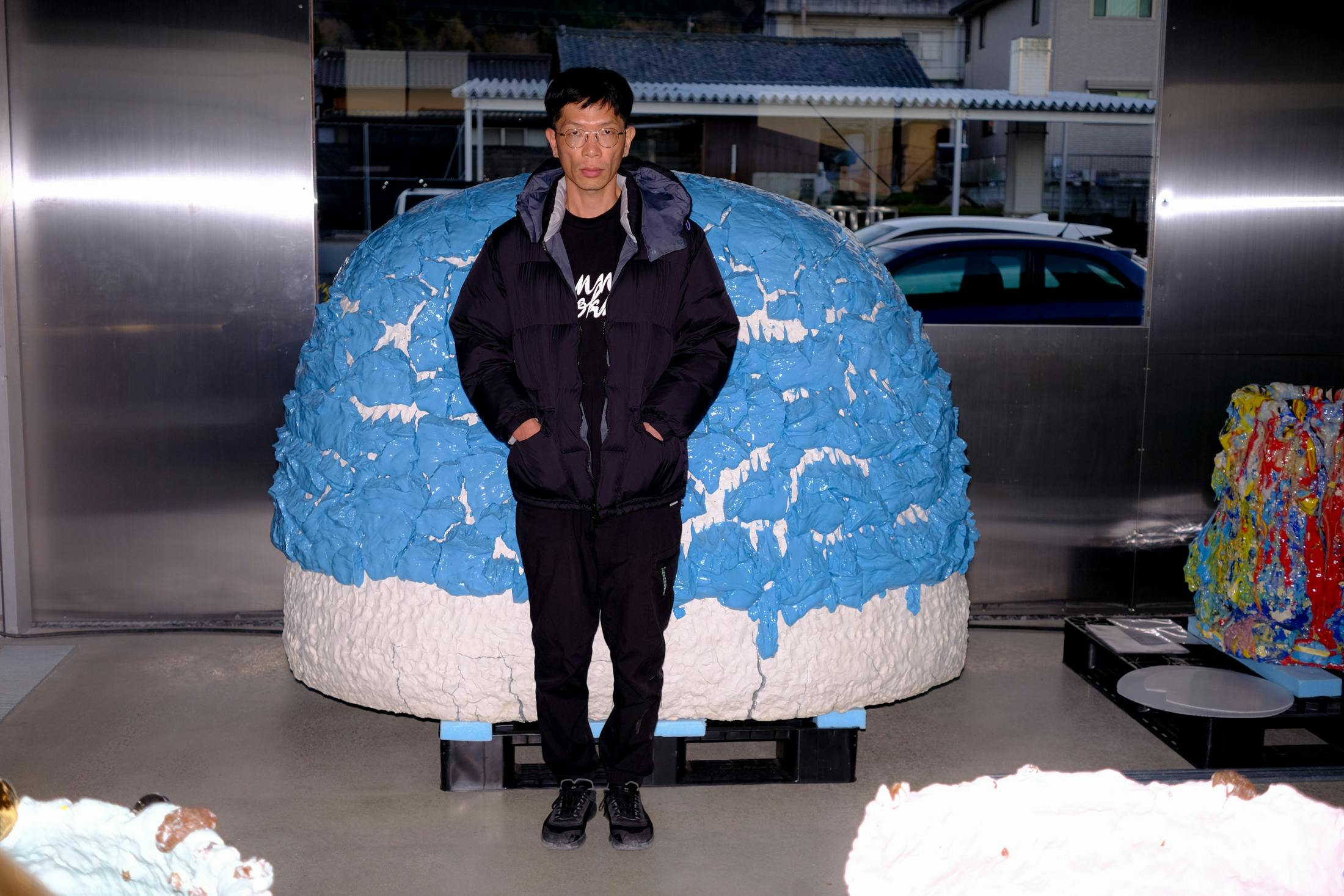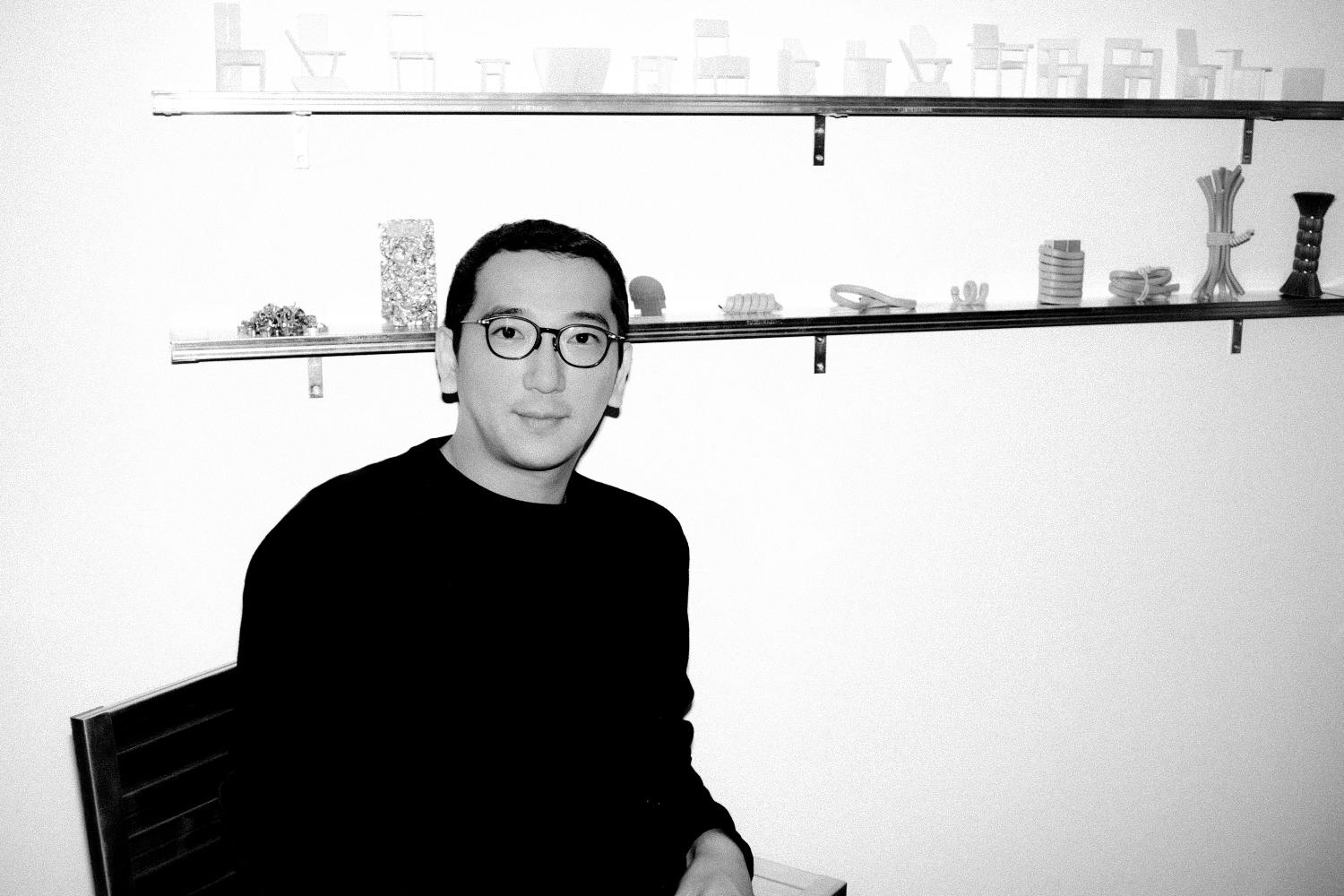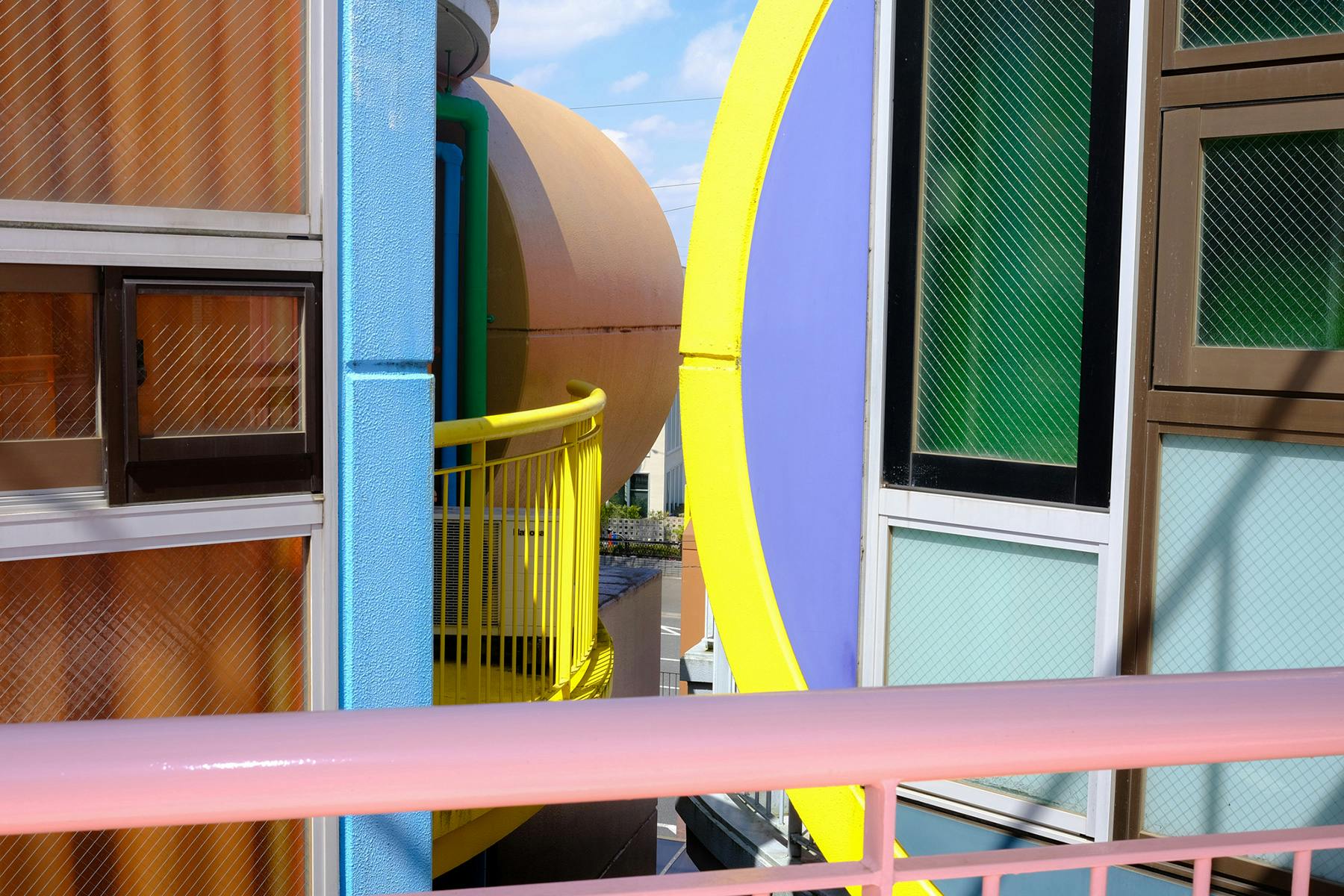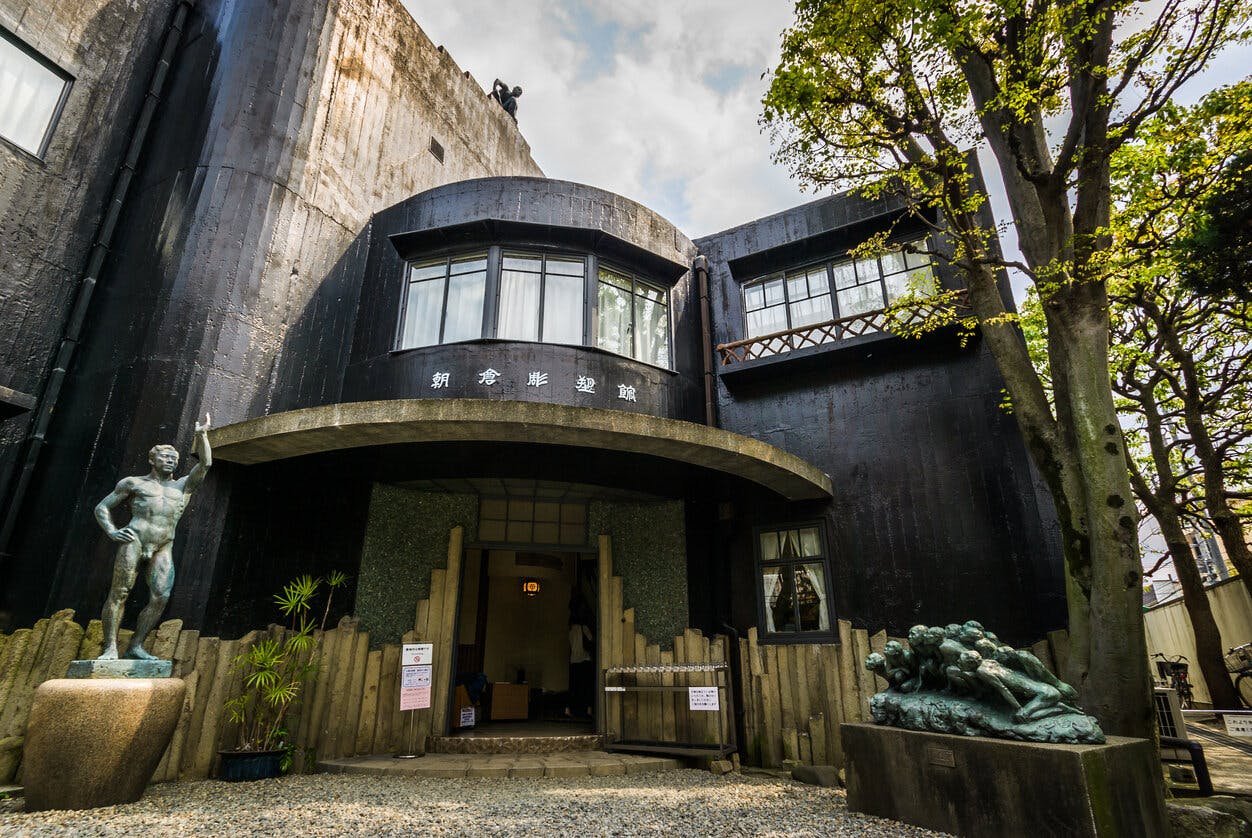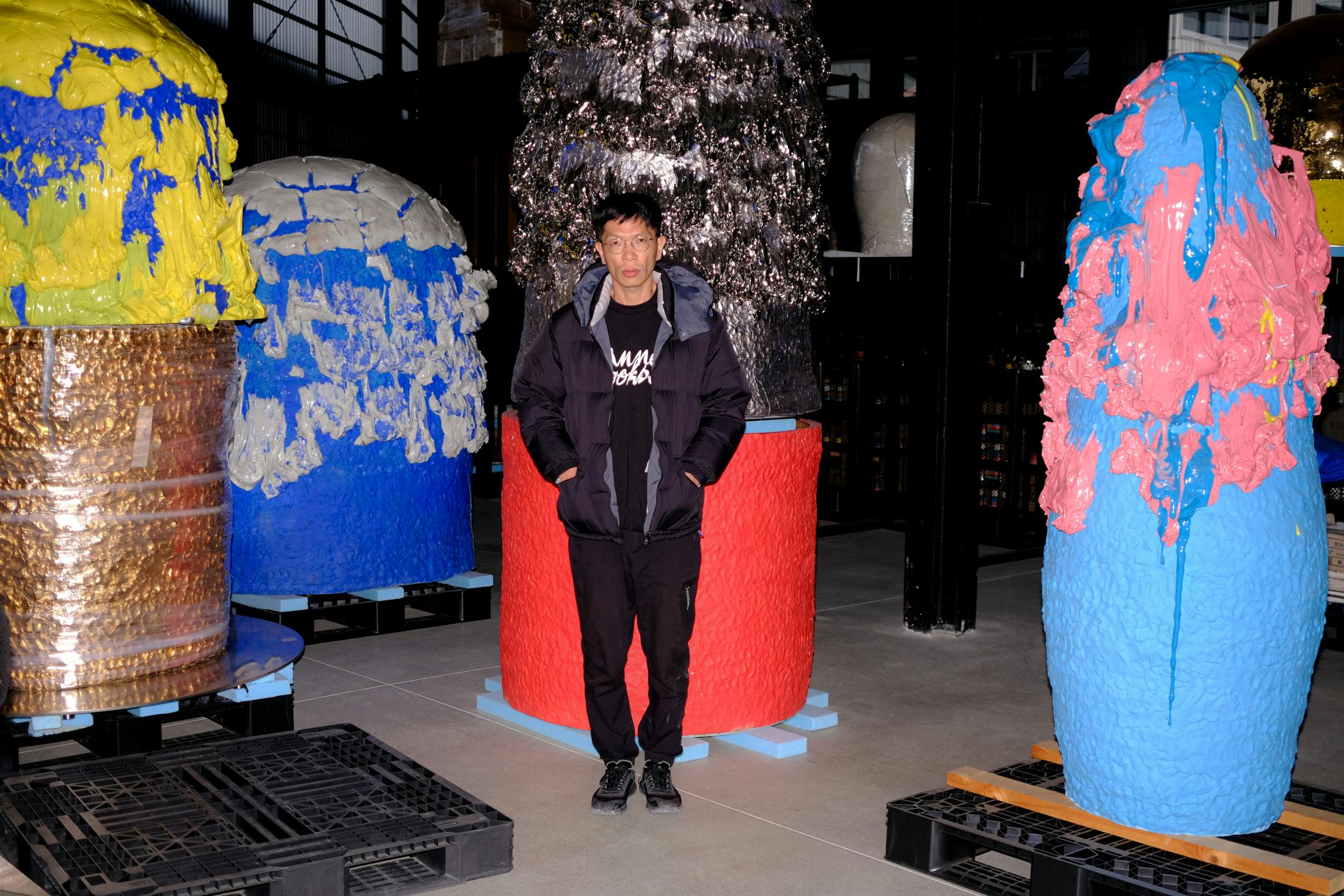
Studio Visit with Takuro Kuwata
We do a studio visit in Gifu, Japan, with Ceramic Artist Takuro Kuwata
Before I even knew about the niche avant-garde ceramics movement Sōdeisha, I came across Takuro Kuwata's work—ceramic vessels unlike anything I'd seen from Japan. The vessels seem to surge and rupture, simultaneously controlled and chaotic, rendered in materials and textures that feel familiar and natural yet transformed by otherworldly colours. One piece stands out in my mind, an almost artificial CMYK-cyan form with slick silver extremities that left me mesmerized.
Kuwata’s practice is deeply informed by a hybrid set of influences: American pop culture, music, and, of course, the experimental ethos of Sōdeisha. His path from breakdancer to ceramic artist is not as incongruous as it might first appear; it speaks to his dynamic sensibility, one that breaks away from the expectations of tradition. In Japan, ceramics, with its millennia of history, is bound by a tacit set of unspoken "rules" passed down through generations of master potters. Yet, with the guidance of progressive professors and sensei who encouraged creative rebellion, Kuwata found his own voice. His trajectory is one we see often—gaining recognition abroad before receiving validation at home.
Now based in Tajima, a region renowned for its ceramic artisans, Kuwata navigates between his atelier, Tokyo, and the many international exhibitions which bring him across the continents. During my initial 6-month stint in Japan, I attempted, without success, to connect with this elusive artist. Then, one evening in Paris, at a dinner during an art week, fate intervened—I found myself seated next to him. We made plans to meet again, this time in Tajima, as winter approached. We discussed his early beginnings, his craft and influences, the rigid rules imposed by older and more traditional generations and more.
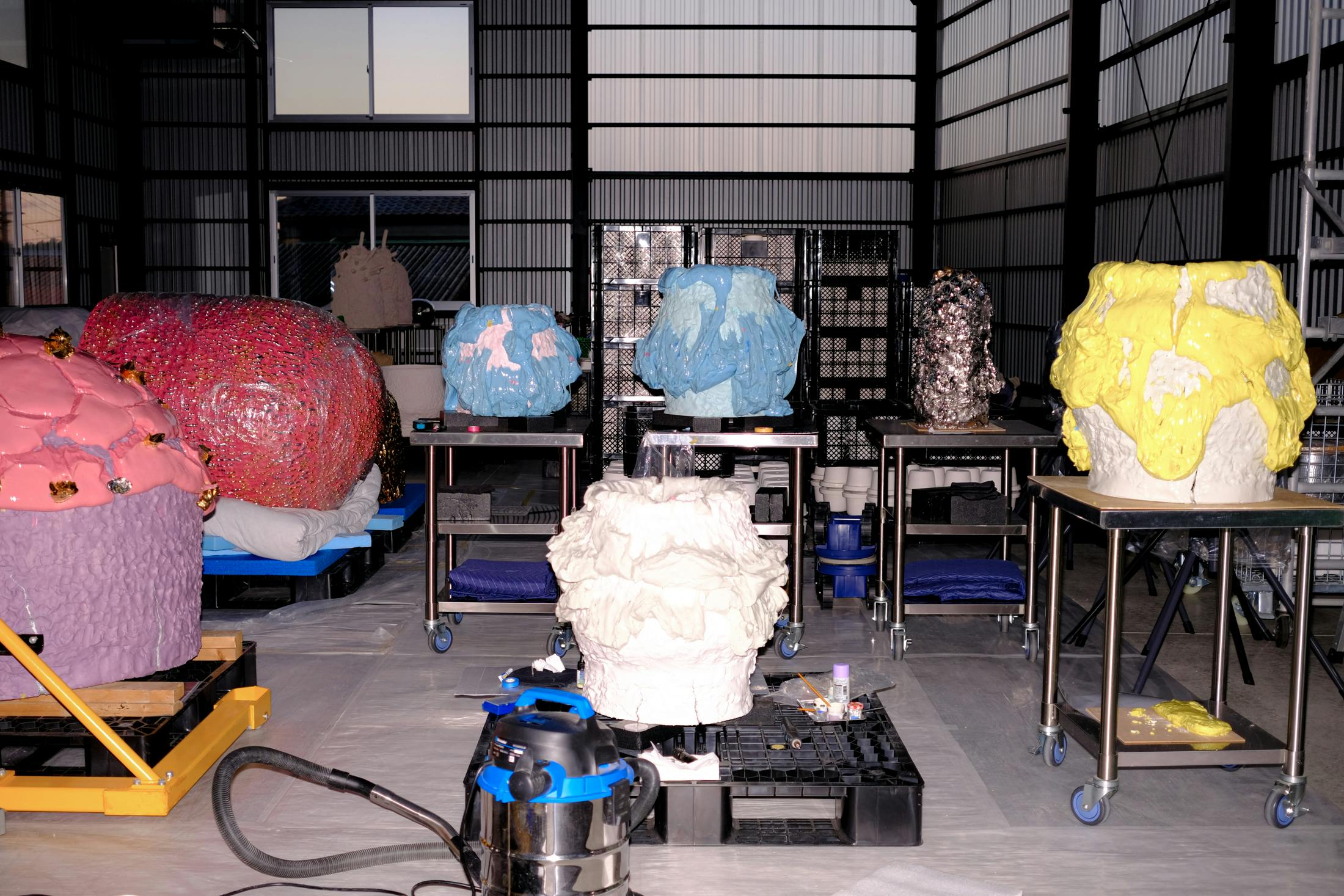
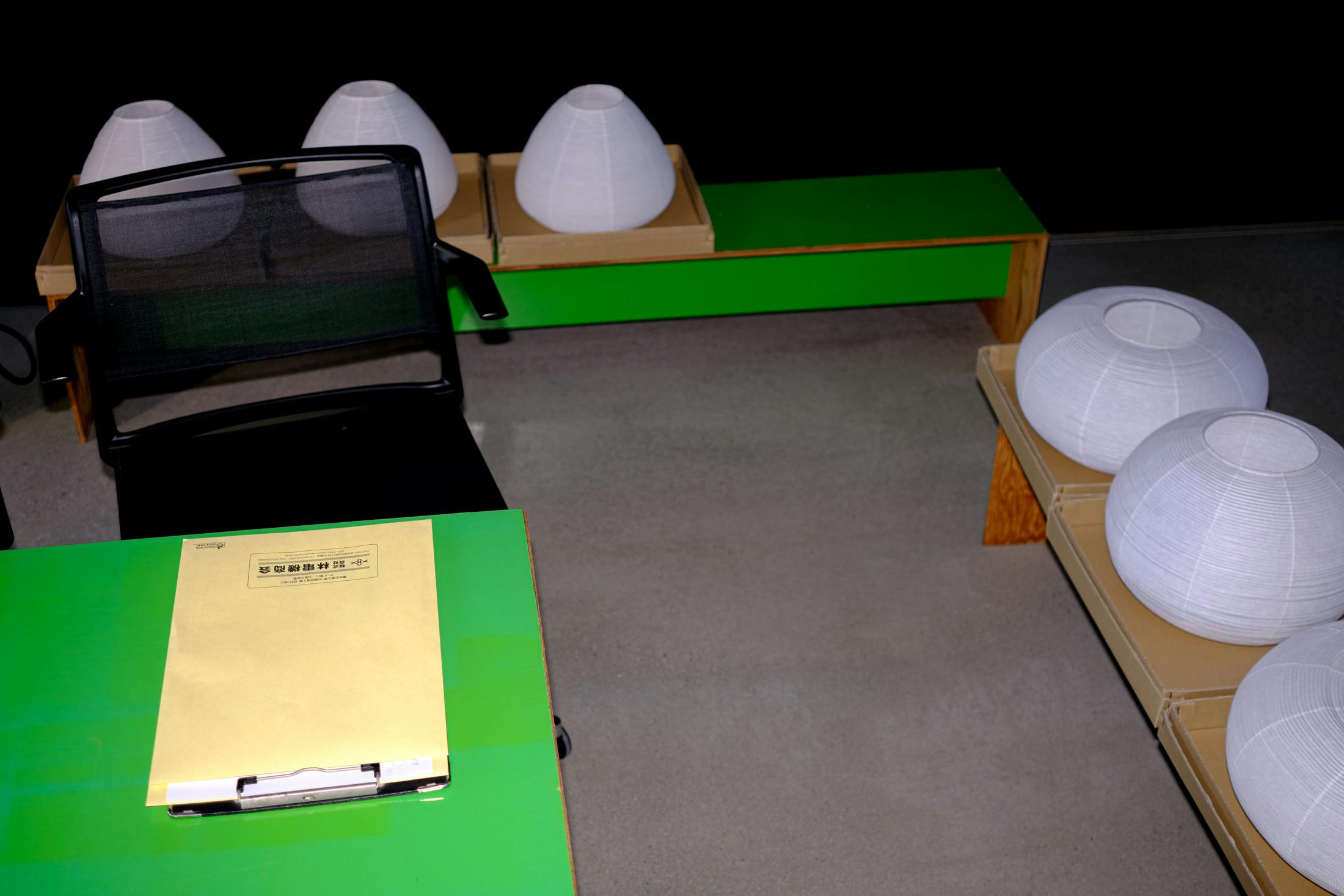
Kristen_ How did you choose your university major?
大学進学はどのように決めましたか?
Takuro_ I wasn’t all that academic, but I enjoyed subjects such as drawing and arts and crafts, which made me think it would be a good idea to pursue a career in the creative field. When weighing up my choices for university, I was attracted by how smart and cool I thought designers were. I even admired them. So, I decided to enrol for design studies. However, I wasn’t good at making precise drawings. My sketches were always all over the place. That’s when I realised that something as formal as design wasn't for me and opted to take an art course that focused more on crafts.
僕は勉強は得意じゃなくて、絵を書くことや図画工作みたいな科目が好きだったから、クリエイティブ系の仕事につけたらいいなってなんとなく思っていました。大学の専攻を考えていた時、デザイナーってすごくスマートでかっこいいイメージがあって、単純な憧れがあってデザインコースに行きたかったんです。でも精密なデッサンが苦手だったんです。僕が描くとラフデッサンになってしまって、どうしても枠からはみ出てしまう。そこでデザインみたいにかっちりとしたものは向いてないということに気がついて美術コースを選ぶことにして、工芸と絵画に分かれるんですけどなんとなく工芸を選びましたね。
How did you become interested in ceramics?
どのようなことをきっかけに陶芸に興味を持ったのでしょうか?
It all started after I graduated from university and became an apprentice. I didn't take university seriously and spent most of my time break dancing. My university professors even told me, “If you’re not going to apply yourself, you might as well quit now.'” It's not the kind of university where all graduates go on to work for a company. So I went to one of my university professors for advice, and they introduced me to a master potter, who took me on as an apprentice. I found the master's works very appealing. The objects created as a dialogue with the materials were very interesting too. For example, he would take sand from areas where the mountain surface had collapsed, and talk about how interesting it would be to use that kind of sand to make pottery. I had a lot of such “live experiences” for example he burned wood and put the ash in boiling water. After removing the lye and filtering, he mixed it with minerals to produce a glaze. In university, we would use ready-made glazes and I didn't know how they were made. So this was a stimulating experience that I had never seen before. I also think that the ability to interact with the materials is amazing, which is probably what appealed to me the most about pottery.
大学を卒業してから師匠に弟子入りしたことがきっかけです。大学時代はあまり真剣に取り組んでいなくて、ストリートダンスばっかりしてました。大学の教授からは「やりたくないんだったら、やめた方がいいぞ」って言われるぐらいだったんです。 でもなんとか卒業を迎えて進路を考えた時に、陶芸の以外の仕事をすることもできないわけで。まわりの卒業生も企業へ就職みんなするような大学でもない。それで、藁をもすがる思いで大学の先生に相談に行ったら、陶芸家を紹介してくれてその方に弟子入りした。師匠の作品がものがすごく魅力的で、素材との対話で生まれるものがとても面白かった。例えば山肌が崩れてる場所の砂を見て、あれを使った作品を作ったら面白そうだな、こんなな焼き物になりそうだな、とかっていう会話をいつもしていました。「生の体験」をたくさんさせてもらったんです。木を燃やしてできた灰を沸騰した湯に入れて、灰汁を抜いて濾過させて、乾燥させたものを鉱物と混ぜて釉薬を作る。大学時代は出来合いの釉薬で、何が含まれているかわからないようなものを使って制作してきた自分にとっては、全く見たこともない感動があった。それから素材との対話ってすごくおもしろいことだなと、焼き物の1番多分魅力を感じましたね。
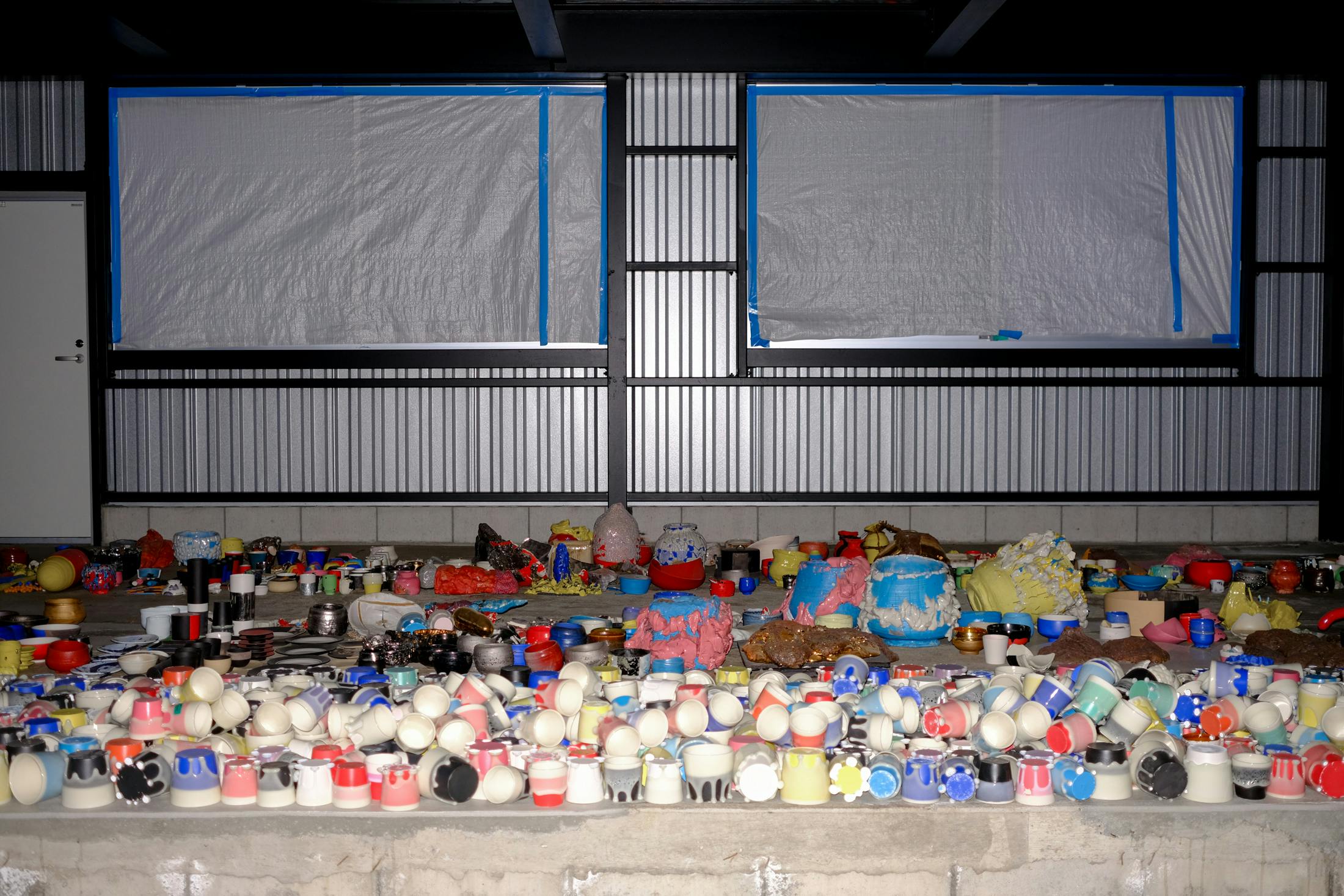
TherewasatimewhenIthoughtthatmyworkwouldneverbeacceptedorunderstood.
Takuro Kuwata
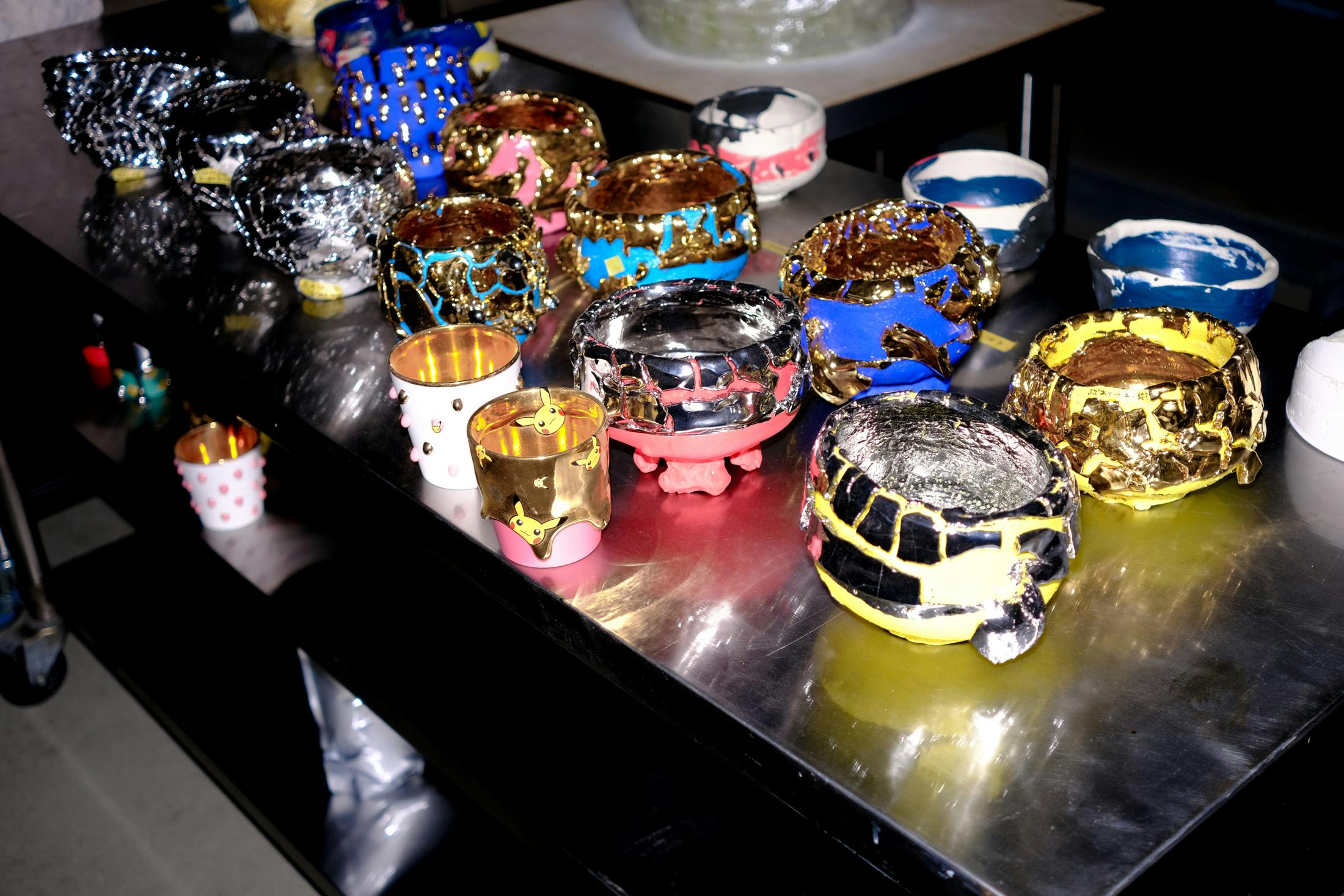
One and a half years seems like a short period of training. How did you learn your craft and decide to go independent?
1年半の修行を経て独立されたようですが、期間が少し短く感じます。どのように学ばれ、その後独立を決めたのですか?
Although it was short, I believe that my training period was very intense. In the traditional Japanese pottery world, apprentices are not even allowed to touch the clay. The master does all the work himself without much help from his apprentices. But when I became an apprentice, the master gave me a pottery wheel to work on next to his. I would help do other thinhgs such as carrying luggage or with difficult tasks, but other than that, I was left to do my own work. I was making and breaking about a hundred teacups and tea bowls every day. My master would notice when I got stuck and would take a moment to explain and teach me the basics. I also started to enjoy studying, reading books, and learning about clay and glazes. That’s when I started thinking to myself “If I keep at it, I’ll be able to achieve something?'' and he said “Oh you think you know a lot. But there’s much more to it…” I enjoyed these conversations and master would let me openly ask anything very candidly.
While I was training, my master said to me, “If you stay with me any longer, my colours will become your colours, so why don't you run a pottery workshop or something as an independent? I can still give you some advice if you bring me your work from time to time.''. From then on, I would visit him only once a week before gradually becoming independent.
短い期間でしたが、弟子入りした修行期間はとっても濃かったと思います。日本の陶芸界で弟子入りとかってなると、最初はなかなか土を触らせてもらえない、みたいな風習があるじゃないですか。でも師匠は弟子の僕にあまりお手伝いをさせずに自分自身で制作を全うするので、弟子入りしてすぐに先生のろくろのとなりに僕が使うろくろを与えてくれました。先生の作業が大変になってしまったら荷物運びなどを僕がお手伝いをする程度で、それ以外はとにかく自分の制作をさせてもらっていた。1日に100個ぐらい、湯飲みや茶碗を作っては壊し、という繰り返しを毎日していましたね。自分が行き詰まっているときは先生が気づいてくれて、一緒に会話しながら基礎を教えてくれました。自分自身も勉強が楽しくなって、本を読んだりして土や釉薬について学んで、「これってこうしたらこんな結果になるんですよね?」「よく知ってるね。そうおもうでしょ?でも実は...」みたいな、子供のときみたいに何でも聞けて、先生が答えてくれるような会話がとても楽しかったです。
そんな修行をしている中で先生から、「僕のところにこれ以上いても僕の色が映っちゃうから、陶芸教室とかしながら自分でやってみれば?それでたまに作品を持ってきてくれたらアドバイスをしてあげるから」と言われました。それで訪問の頻度を週に1回にして、徐々に独立していきました。
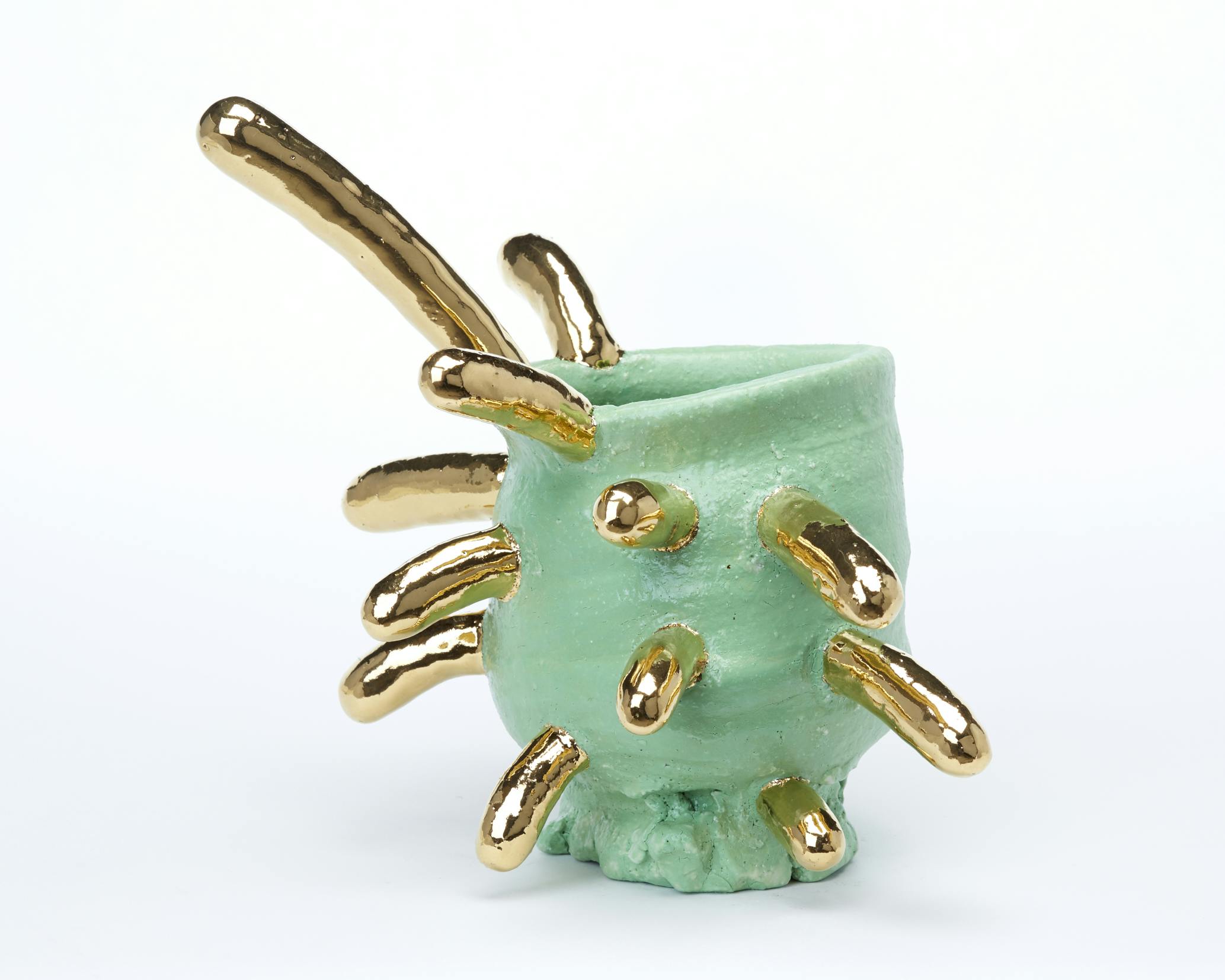
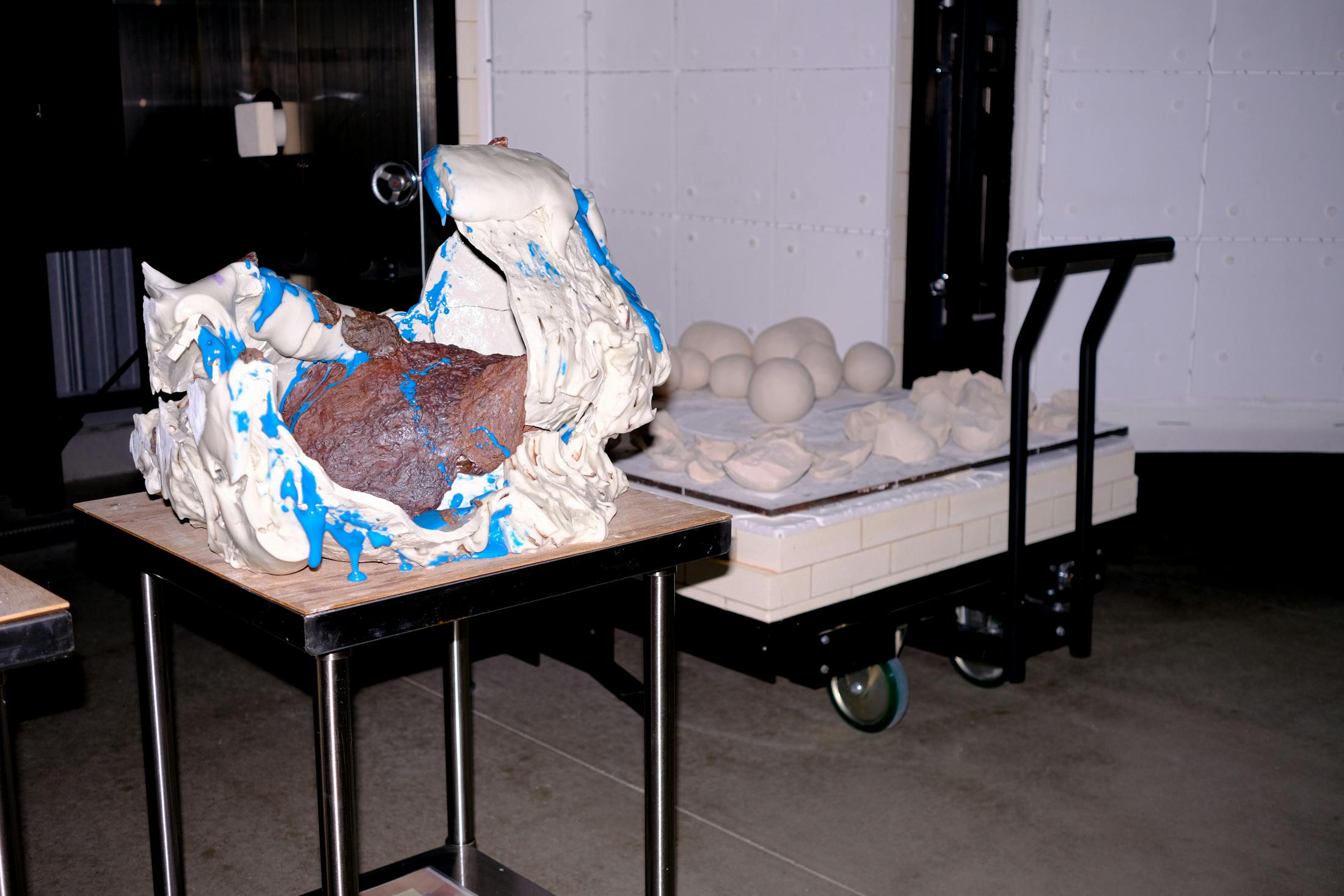
How were you influenced by the Sodeisha movement?
桑田さんは走泥社のムーブメントからどのように影響を受けましたか?
I was strongly influenced by it when I was in university. Many Kyoto universities' ceramics departments have professors who were involved with Sodeisha. That's why I ended up making so many of these objects in my university classes. Of course, students make things like bowls and plates as part of their basic studies, but when we made something like that on our own, the university professors would say “Is this what you came here for? It's okay if you go and do your own thing”. Nevertheless, Sodeisha is avant-garde ceramic art, and since that’s what I was taught, it has greatly influenced what I make today. Japanese pottery has this image of making traditional pots, but my teacher hated that kind of thing, it was very refreshing. When I was in university I was fascinated by works that could make me reflect and say “Is this ceramic art?''. That's why I made these types of objects for my university graduation project.
What's interesting about Sodeisha is the way they approach things, and how they transform what they make with clay into their own expressions. Even when making objects, it is important to think about the meaning behind making something out of clay instead of another material. That’s something I think about a lot.
大学の時に強く影響を受けた。京都にある大学の陶芸科の多くは、走泥社に関わった人が教授として在籍しています。だから大学の授業の中でオブジェを作るんです。もちろん基礎的な勉強として学生は茶碗やお皿なども作るんですけど、そういうオーソドックスなものを自主制作で作ると大学の先生たちから「君は何しにここに来たんや、そんなのはここに来てやらんでいい」って言われましたね。走泥社は前衛陶芸ですが、その流れのなかで学んできたので、僕は少なからず自分の制作活動に影響を受けています。日本の陶芸はトラディショナルな壺を作るようなイメージのあるものですが、僕の先生はそういうものを嫌がっていた。それがすごく新鮮だったし、「これって陶芸なの?」って思えるような作品に大学の時はすごい憧れていました。だから僕の大学の卒業制作も、オブジェを作りました。
走泥社の面白いところは、土でつくることをどう自分の表現に変えていくかっていう、アプローチの方法です。オブジェを作る中でも、別の素材で作ればいいものを土で作る意味を考えながら作ることが重要で、僕もとても考えています。

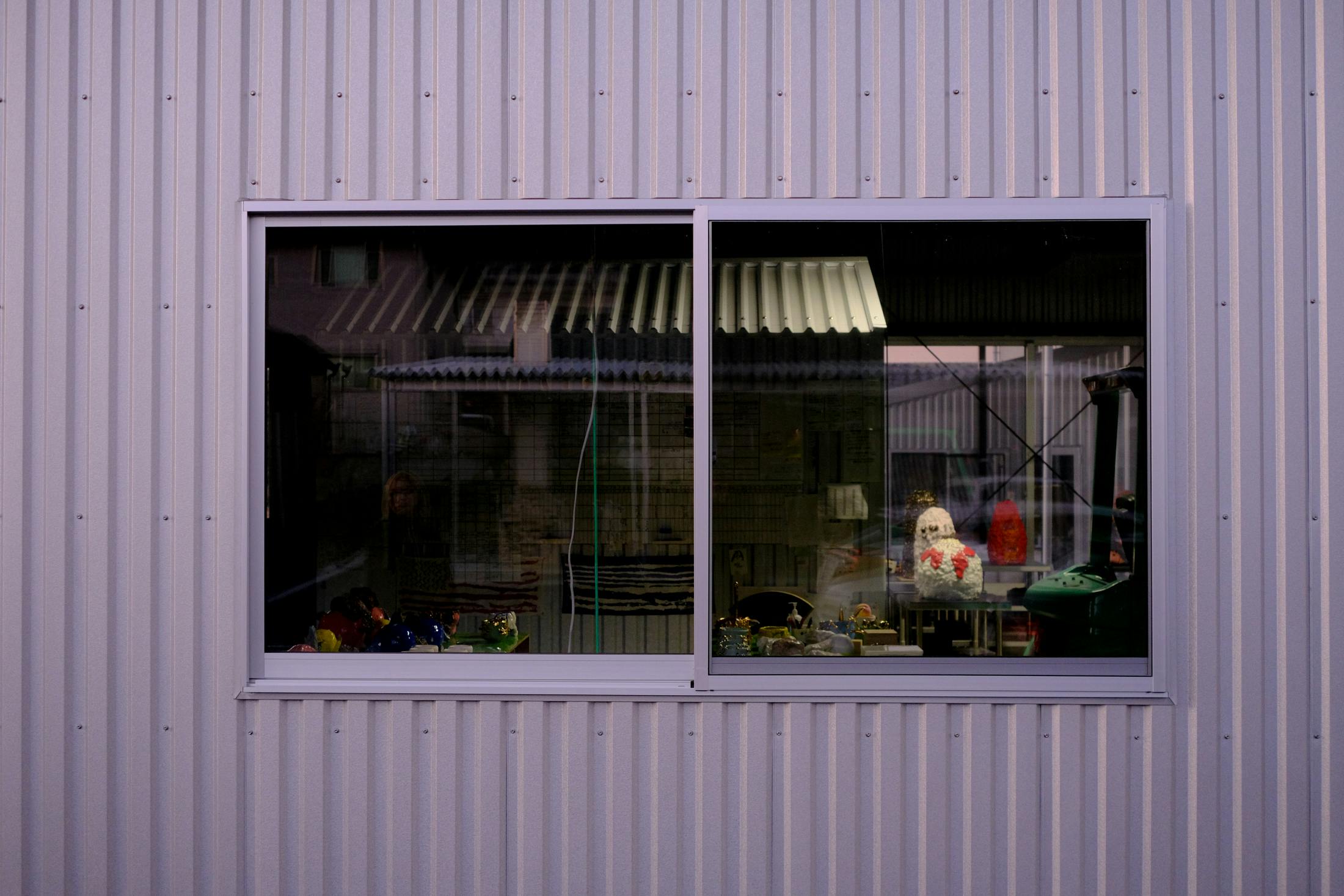
What I have noticed while living in Japan is that art, design, and crafts are divided into genres, and there are very few creators who work across these fields. However, I feel you are one of the few who does that cross-over. How are you perceived by the Japanese market and the people involved in traditional pottery?
日本に滞在していて気がついたのですが、アートやデザイン、工芸と、それぞれジャンルとしてはっきり分かれていて、横断的に活動しているクリエイターはあまり多くないですよね。そんな中でも、桑田さんはジャンルを横断して活動されています。ご自身は国内や、伝統的な陶芸に従事している方々からどのような印象を持たれていると感じますか?
When I exhibited in New York for the first time, a lot of people were telling me “Your work is amazing”. Because I’d been listening to American music and was familiar with Western culture, I think it brought me closer to the people there. On the other hand, as someone who works in pottery in Japan, I find it difficult to convey my feelings, especially to older generations. I sometimes find it extremely sad that people see me as just making something that’s in a category of its own. While we get praised for doing something that hasn't been done before in ceramics, at other times people think we're just being reckless. Even today, some people find it hard to grasp that what I do is not at all reckless but rather done with a purpose.
There are immutable concepts in ceramics, there is a tendency to evaluate things for having been meticulously made, being delicate, or requiring a lot of effort. I think this is probably a typical Japanese trait. Of course, I don't dislike such works, but I think my style is to build something different while learning about other genres. I make container objects that can express and convey things like communication tools. Sometimes I hear comments such as “This doesn't go well with the dish”. But I don’t mind because I know this is how I express myself. Even when I was an apprentice, if I wanted to colour a traditionally shaped bowl vivid pink, seven though some people would reject it on the base of the colour alone. There was a time when I thought that my work would never be accepted or understood.
初めてニューヨークで展示した時、現地のお客さんから「君の作品やばいね」って言ってもらえたことがありました。僕自身がアメリカの音楽を聞いたりとか、西洋文化に親しんでたところがルーツにあって、それが鑑賞者との距離を近づけてくれたのかなと思うわけです。逆に日本で陶芸をやってるひとからするとその感覚がなかなか伝わらず、世代が変わっちゃうと特に、「変わってるもの作ってるだけ」みたいなに思われてしまうのがすごい切なく感じる時があります。今までセラミックの歴史で、これまでやられてこなかったことをやってるっていう評価も受けることもありますが、 ただ無茶苦茶やってるって思われることもあったりする。でも、全然これは無茶苦茶ではなくて、意図的にやってることなんだよっていうことは、もしかすると今でも伝わってないかもしれません。
日本には陶芸の固定概念みたいなものがあって、 例えば精密なつくりだったり繊細なものだったり、手間かかっている、みたいなものに評価される傾向がある。これは多分、日本人の価値観として一般的なんだと思います。僕ももちろんそういう作品は嫌いではないですが、そうじゃない積み重ねていくものが僕のスタイルだと思う。例えば他のジャンルのことを知るとかもそう。僕は1つのコミュニケーションツールとして、器型のものを作っています。極端な例ですが、僕が作った器を「これだって料理に合わないじゃん」とかっていうコメントをされることもある。 でも、自分がやってる表現ってのは「これ」なんだって、軸をぶれさせることはないです。弟子の時代に、伝統的な形状をした器に色を付けたいと思ってピンクにしてみても、もうその色だけで拒否反応を示す人もいる。だから、自分の作品を理解してもらうということはなかなか難しいなと思いながら活動をしていた時期はありました。

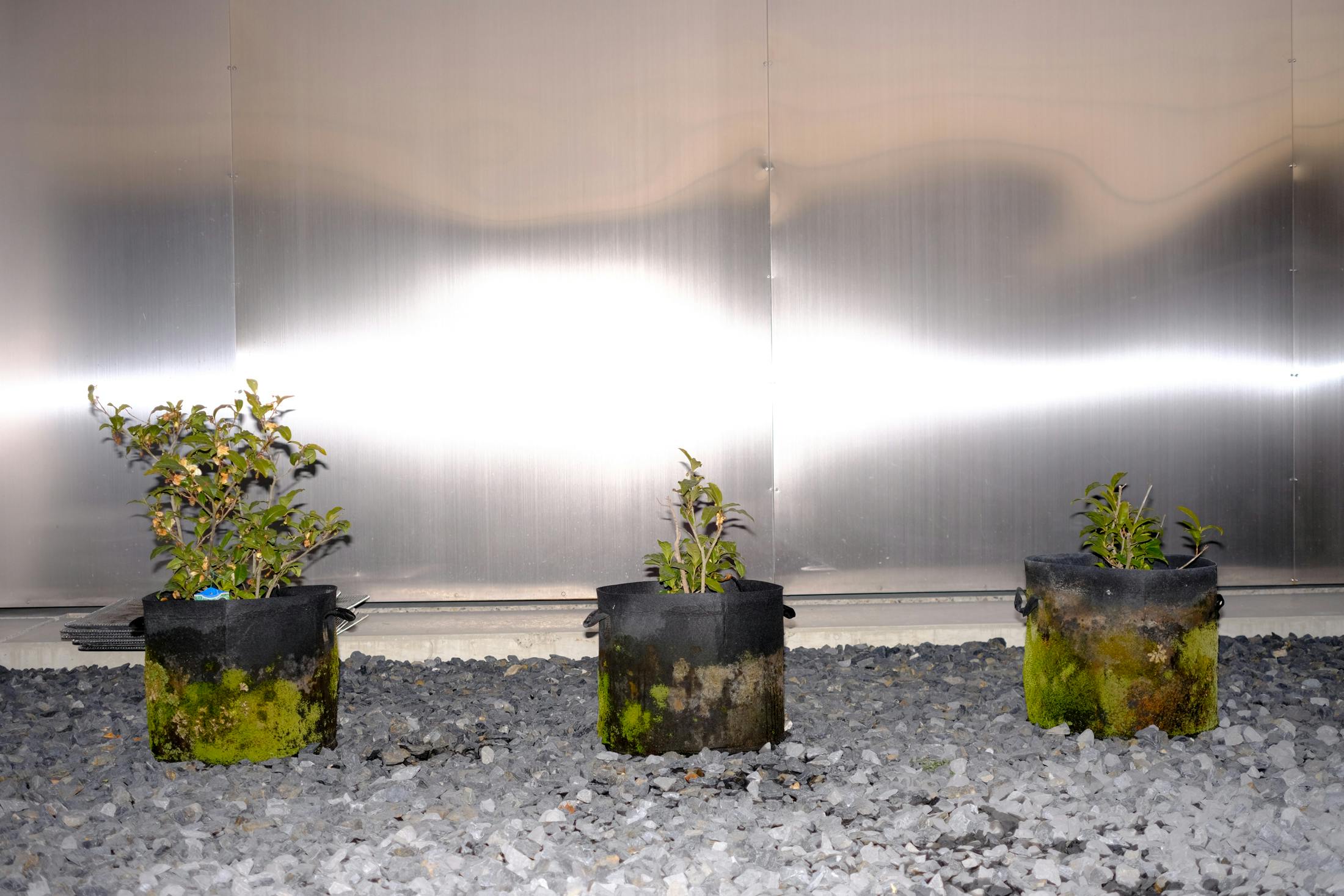
Have people made fun of your art or have you ever felt shunned by others?
誰かから揶揄されてしまったり、周りからご自身が心を閉ざしてしまうことはありましたか?
Of course, at times I would ask myself how I could get these people’s approval. I would focus on creating works that could win competitions. I studied to be recognised for my technique and applied myself to win awards based on those criteria. Maybe I would have developed my current style much faster if I had only focused on what I liked instead of doing all that. But looking back on it today, I think it was a good experience for me.
By believing in myself and continuing to create, I was able to receive positive feedback from famous masters and people who love avant-garde ceramics. People from different generations bought my work and said, “I don't get where it’s coming from, but I see what you're trying to do”, and I would even receive support from people older than my father. It was really encouraging. I also received a lot of positive feedback following my shows outside of Japan, which made me think I should keep at it.
もちろんありましたね。批判に対して、どうしたら評価してくれるんだろうと思って、コンペティションで賞を狙いに行くような作品づくりに注力した時もありました。テクニックで認められるために研究して、その価値観でどうやって賞を取るかを真剣に取り組んだこともある。もしかしたら、そんなことはせずに自分の好きなものだけを突き進んだ方が、いまのスタイルに辿り着くまで早かったのかもしれない。でも今は、それはそれで自分にとって良い経験になったと思えます。
そして自分を信じて制作を続けた先に、有名な巨匠や前衛陶芸を好きな方達から 良い反応をもらうこともできた。「世代は違うから俺にはノリはわからないけど、君がやろうとしていることはわかる」といって作品を買ってくれる人がいたり、自分の父親よりももっと上の世代の人が応援してくれて、本当に励みになりました。それに、海外での展示でたくさんの良い反応をもらって、このまま突き進んで良いんだと思えるようになりましたね。
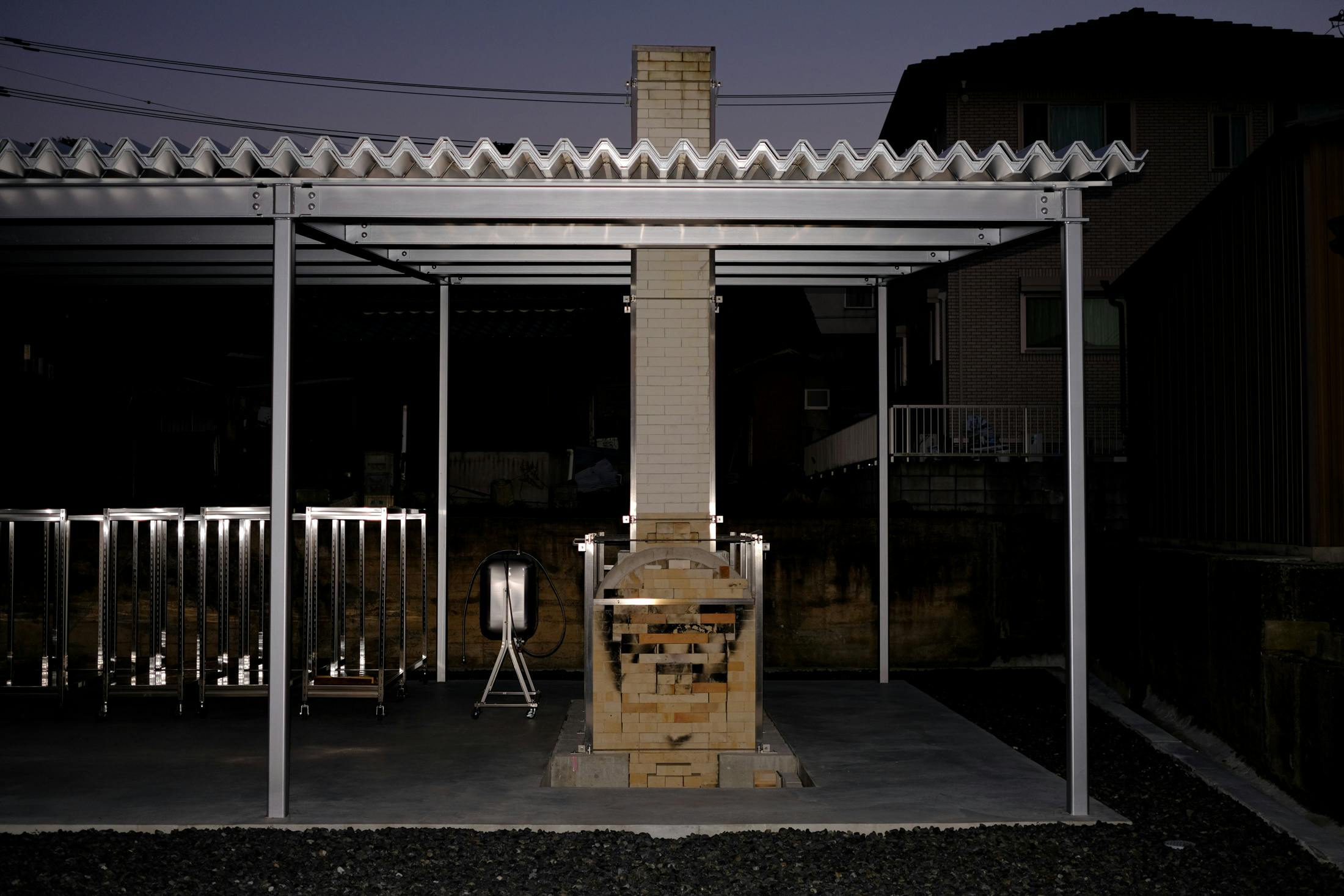
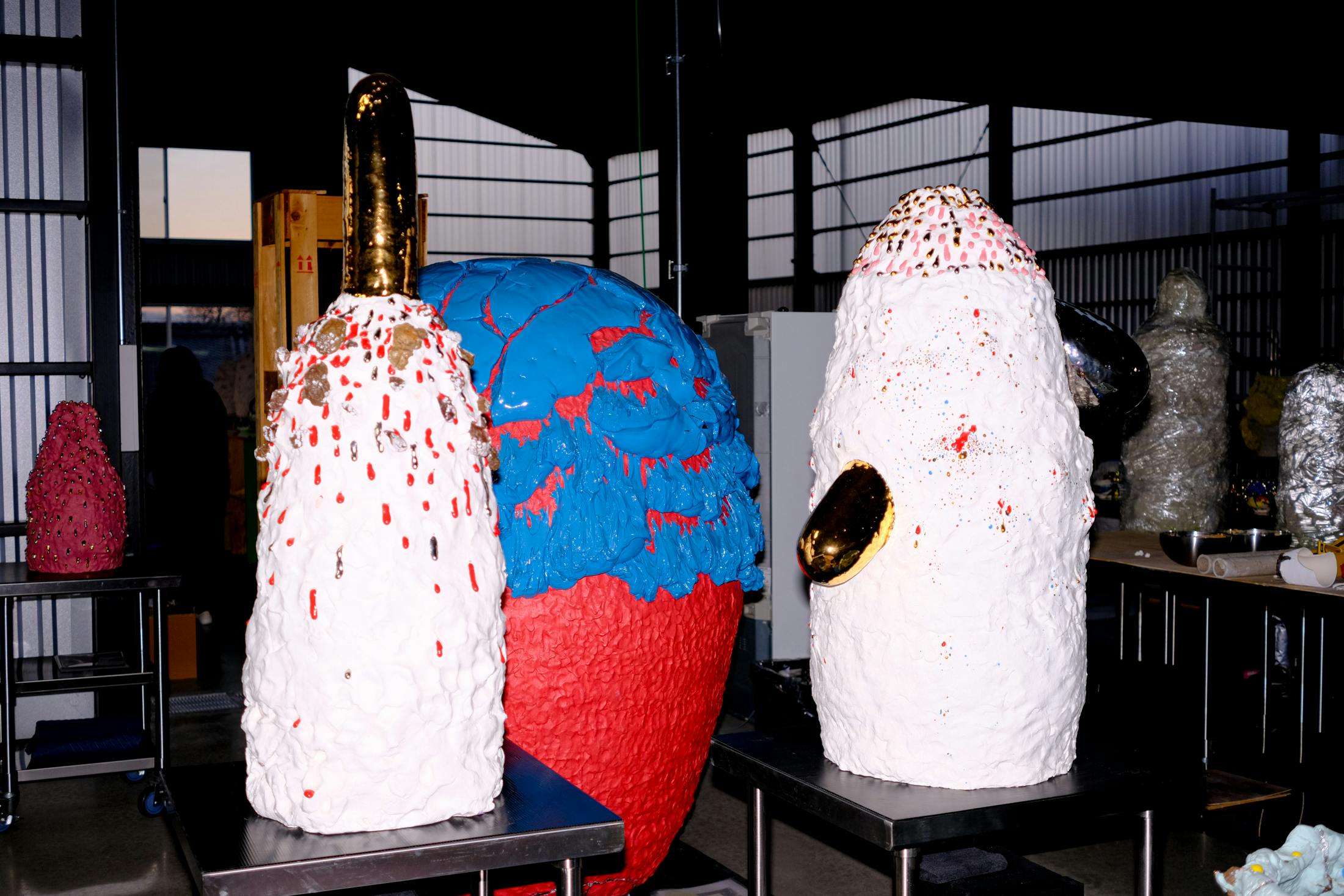
Do you feel that your reputation in Japan has changed as a result of your international success?
海外でご活躍されたことで、日本での評価が見直されたと感じられますか?
Yes, very much so. I don't think anyone could have imagined that an artist like me would get any international recognition doing more contemporary art over the kind of work that is generally acclaimed in the Japanese ceramics industry. Although I am recognised as being part of a new style in Japan, I don't think many people in Japan know that my foundations are based on Sodeisha and traditional techniques. I received the Japan Ceramic Association Award, but that’s mainly because of the great success abroad and the influence it had on young people. Without that kind of support, I might not have been considered in the same way. I particularly like pottery, and I studied it by reading books in an era before the internet, therefore tradition and history were part of my traditional learning path. That's why I'm so grateful to be able to talk with you about my roots and the influence of Sodeisha.
すごく感じますね。日本の陶芸業界で評価されているような作品ではなくて、僕のような作家が現代美術として海外で評価を受けているということは、周りのみんなは思いもしなかったのではないかな。僕は日本において新しい風としての認知はされていますが、僕のルーツが走泥社や伝統的な技法に基づいているということも国内ではあまり知られていないと思います。日本陶磁協会賞をいただいたりしたけど、その理由も海外での評価が高いとか、若い人に影響を与えているっていうことが受賞の理由だった。そういう評価がなければ、僕は変わった人だったっていうだけになるかもしれないですね。僕は陶芸が本当に好きで、今みたいにネットとかがない時代に本を見て勉強してきたから、伝統的な自分自身のルーツに違いない。だから今回のようにクリステンと、自分のルーツや走泥社から受けた影響についてお話しできるのは本当にありがたいです。
How has integrating the Gifu scene in your foundation affected your production activities?
岐阜を拠点として選ばれて、制作活動にどのような影響がありましたか?
Pottery was made in Gifu even before the various techniques that we know today were invented. I feel the history and the many technical aspects of Sen no Rikyu’s time, which preceded Sodeisha. It allowed me to get a better perspective on the industry, including the fact that the industry has shrunk due to China's mass production of ceramics, and what my role and work as an artist is in this context. I started thinking about where I should go from there. I often use the shape of a tea bowl as a template, and since the culture of tea ceremonies is deeply rooted in this city (Tajimi-city in Gifu), I am also sensitive to updating the history of tea bowls as an artist.
今のようなさまざまな技法が生まれる前の時から、焼き物作ってる場所が岐阜。技術の蓄積とか、 走泥社よりもっと前の千利休の時代の歴史をすごく感じます。日本からセラミックの生産地がが中国の大量生産によって産業が縮小してしまったことも含め、 この産業についても深く考えるきっかけになったし、その中でアーティストとしての自分自身がどう制作活動をしていくべきであるか、存在意義について考えるようになった。茶碗の形をモチーフにすることが多いんですけど、 茶の湯っていう文化がこの街に根付いてることから、僕がアーティストとして茶碗の歴史をアップデートしていきたいという意識もあります。
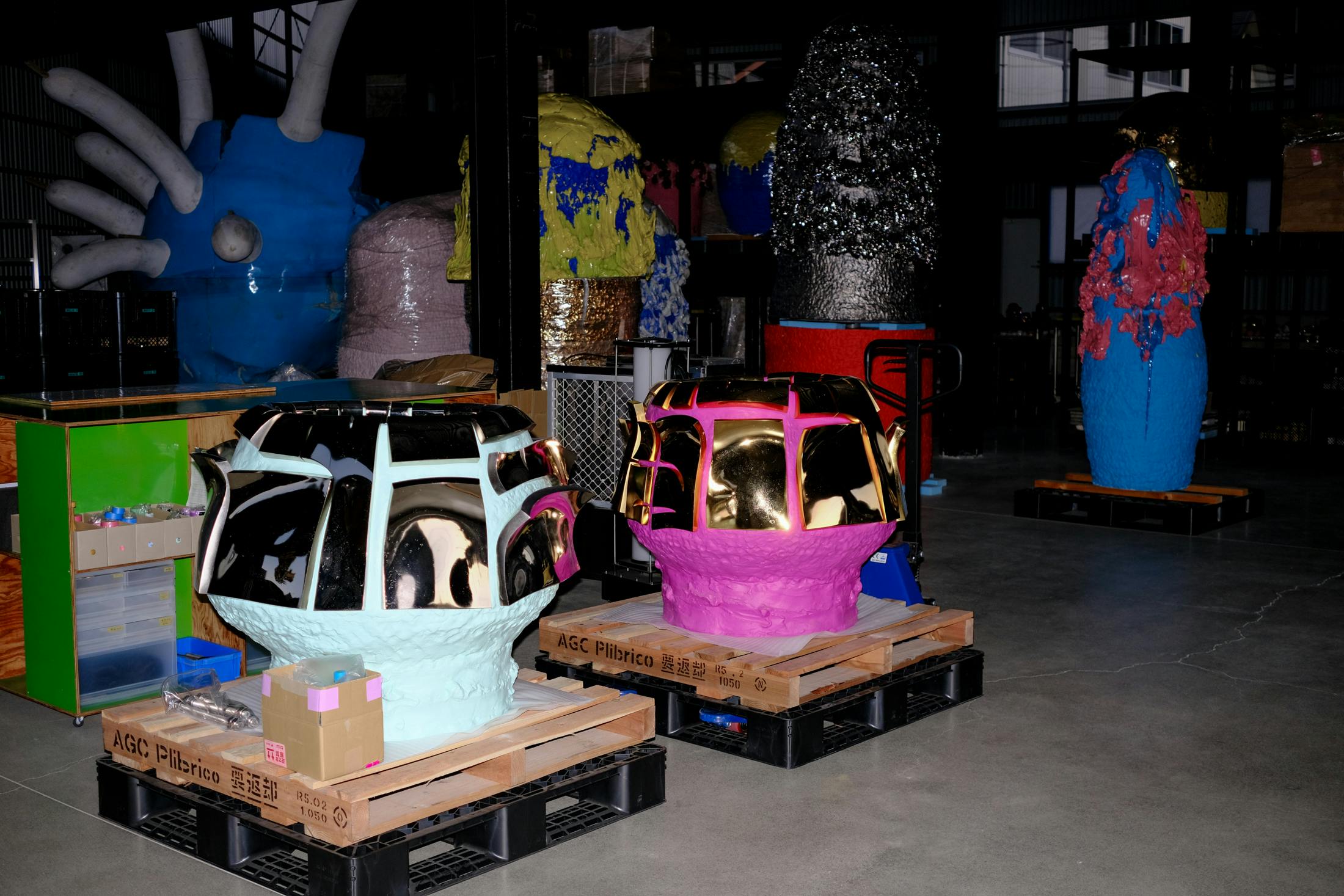
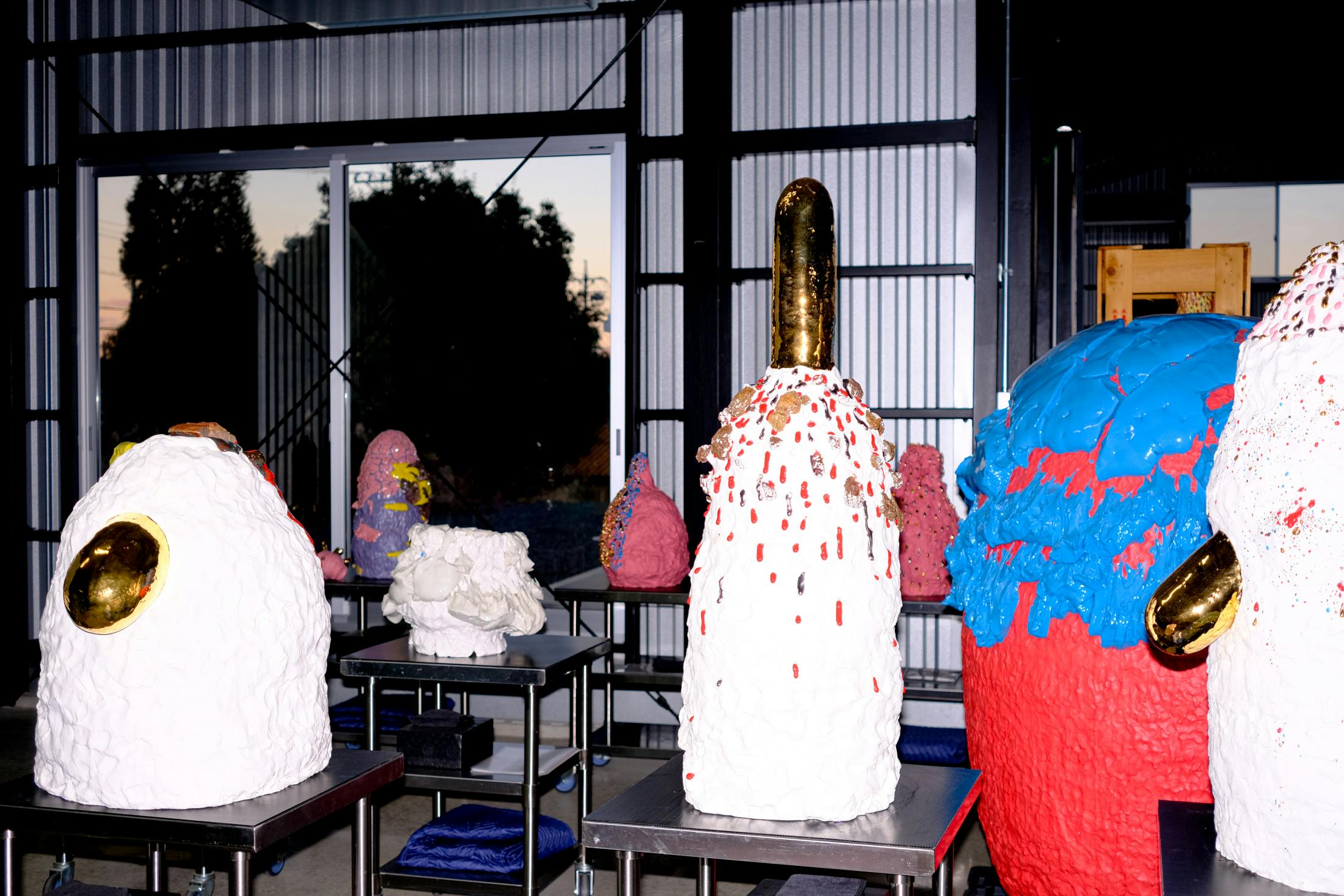
Do you find it difficult to connect with gallerists and collectors if you live in a region like Gifu rather than a big city? Is it a barrier?
大都市ではなく岐阜のような地方にいると、ギャラリストやコレクターと繋がりを持ちにくいなどが障壁になることはありますか?
I like going away and having fun now and then rather than spending every day in the city. I can see my surroundings much more objectively when I go to the city only once in a while. Also, people in the city may find it interesting that I live in a rural area. But of course, I often visit Tokyo and I also want to travel to New York more in the near future.
僕は毎日都市で過ごしているよりかは離れて、時々都市へ遊びに行くくらいが好き。その方が周りをすごく客観的にも見える。それに、僕が地方にいるからこそ、都会の人に興味を持ってもらえるということもあるかもしれないですね。でももちろん東京にもたくさん足を運ぶし、これからもっとニューヨークに行き来したいという思いもあります。
I think the same way. By doing so, you can focus on your own activities and value your time.
私も同じように思います。そうすることで自分自身の活動に集中したり、時間を大切にすることができますね。
I read in an article that you were influenced by Toyozo Arakawa and Rei Kawakubo. What are those influences?
荒川豊蔵さんや川久保玲さんから、影響を受けられたということを記事で拝見しました。どのような影響だったのでしょうか?
Toyozo Arakawa was a potter from the Showa era and a living national treasure in Gifu. Actually, my Crack series is very much influenced by his work. Many of his works specialise in glazes, and when I went to his retrospective exhibition, there was one work where the glaze was peeling off. I thought it would be interesting to expand on that, with my Cracked Glaze series. Although, I'm sure many people may think that my work and Toyozo Arakawa's atmosphere are completely different.
Rei Kawakubo is simply a legend. She is always trying new things with materials and designs that no one would have thought of before. I have a strong admiration for people who create things that make a difference in our field, even if they are in a different genre than mine. I like avant-garde things, and I want my ceramics to be like that.
荒川豊蔵さんは昭和の陶工であり、岐阜で活動をされていた人間国宝です。実は僕のクラックシリーズは、彼の作品からとても影響を受けています。彼は釉薬に特化して作品をたくさん生み出していますが、僕がその回顧展に行った時に、釉薬がベロってめくれている作品があったんです。それを拡張したら面白いなと思ってできたのがCracked Grazeです。きっと多くの人は僕の作品と荒川豊蔵さんの雰囲気が全然似つかないって、きっとみんな思うかもしれません。
川久保怜さんは、もう単純にレジェンドです。だれも思い付かないような素材とデザインで常に新しいことをやられている。自分とは違うジャンルだけど、業界に一石投じるようなものづくりをする人に対して強い憧れがあります。僕はアバンギャルドなものが好きだし、自分の陶器の活動もそうでありたいなと思います。
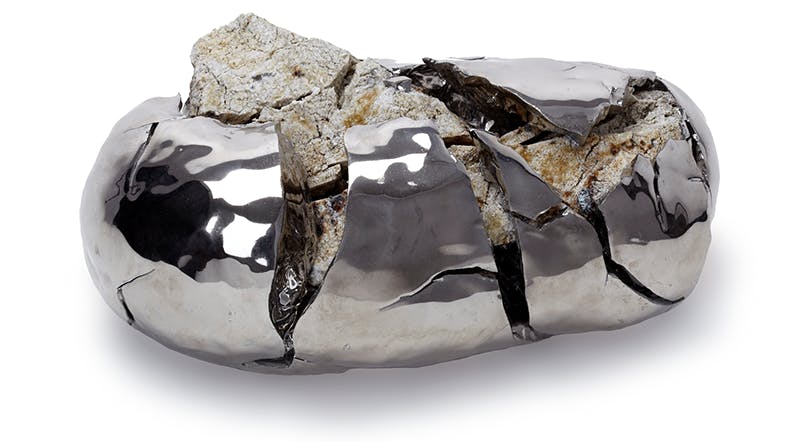
What is the process used to create works that mix stone with glaze to create an explosion? Also, please tell us about the philosophy behind it.
釉薬に石を混ぜて爆発させる作品はどのようなプロセスで制作されますか?また、その裏にある哲学について教えてください。
There is a traditional method called stone bursts "Ishi-haze" where the soil should be purified and free of any impurities. When ancient tea masters started burning clay and mixing it with stones, the explosion, this unique experience was subsequently established as a technique. I also thought it was cool and interesting, so I tweaked the stone-burning technique in my own way and started expressing it so that it could be visible even at a distance.
石はぜという伝統的な手法があります。普通、土っていうのは精製されて何も不純物がないのが良いとされるんですが、かつての茶人が石が混ざっている土を焼いた時に爆発している様子がユニークだったので、技法として確立しました。それを僕もかっこいいな、面白いなと思ってて自分なりの石爆をデフォルメして、遠くから見てもその石爆が分かるように表現するようになったというのが経緯です。
ポケモンやロエベなどたくさんのコラボレーションは、どのようなプロセスで制作をされていますか?またそのコラボレーションがご自身の活動にどのように影響されているか教えてください。
What does the creative process look like for your many collaborations such as Pokemon and LOEWE? How has this collaboration influenced your own activities?
I find it very important to focus on activities that you can do alone, such as interacting with materials. However, some creations cannot be made by one person alone. In that sense, it’s very important to connect with others and meet many different people who can give you new perspectives and help you realise things you didn't think of by yourself. I’m fascinated by the idea that such conversations can help you discover new things that you like. When someone shows me something that I couldn't see, I feel it expands my work and it becomes a communication tool that helps bring in new people. That's what makes it fun.
素材との対話するような、自分1人だけで行うような活動は自分1人で集中して行うこともとても重要です。でもやっぱりやっぱ1人だけでは作れないクリエイションもある。社会とつながることもとても大切で、いろんな方と出会って新しい目線に気づいたり、自分じゃ気づかなかったことに気づかせてくれたりする。会話をすることで生まれる新しいものが、自分の新しい好きを増やしてくれる。僕はそこにすごい魅力を感じています。作った作品について、自分が見えてなかったところを他の方が反応してくれたりした時に、そこからまた広がりが感じるし、作品が1つのコミュニケーションツールになってまた違う人を呼んできてくれたり。そういうところが楽しいですね。
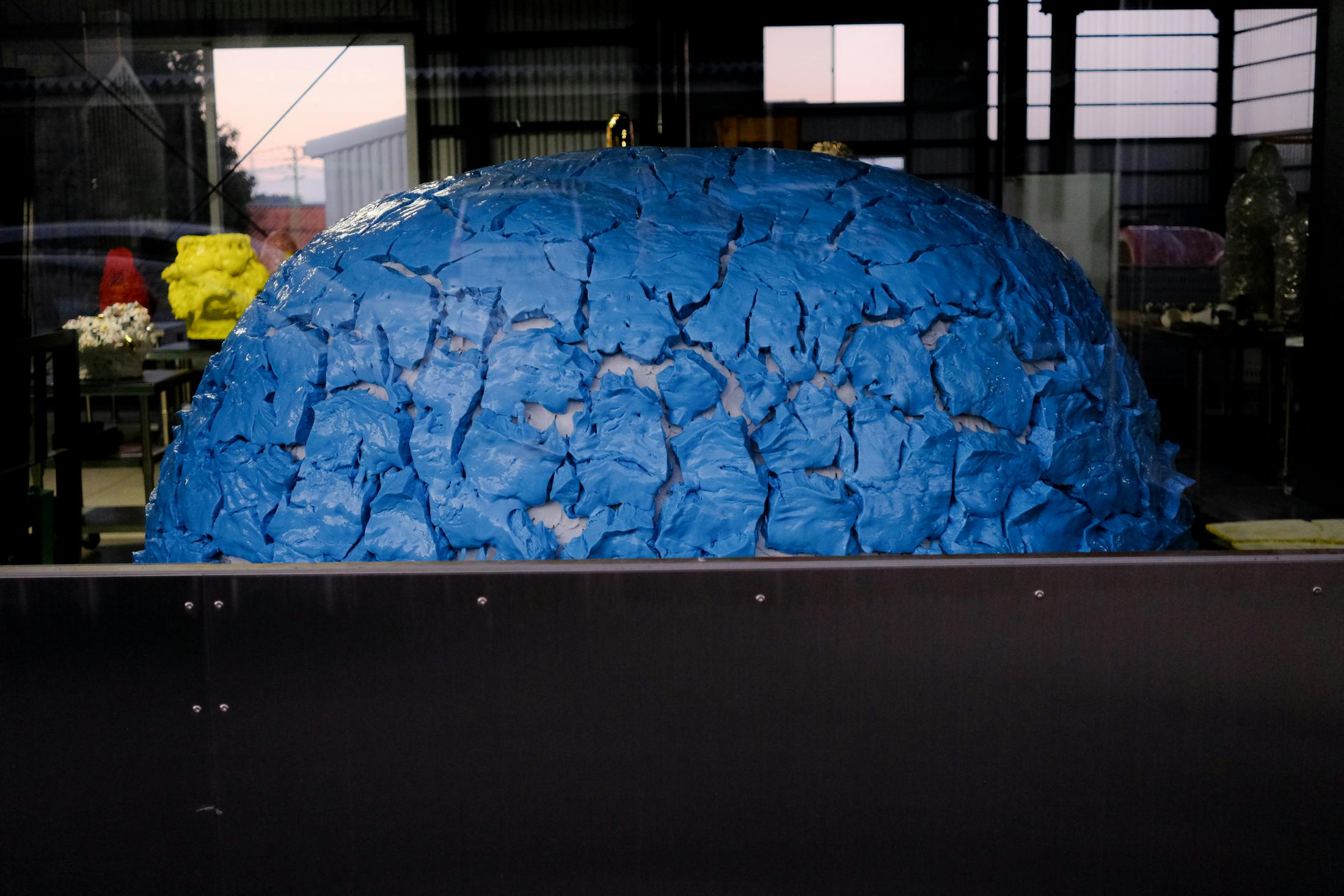
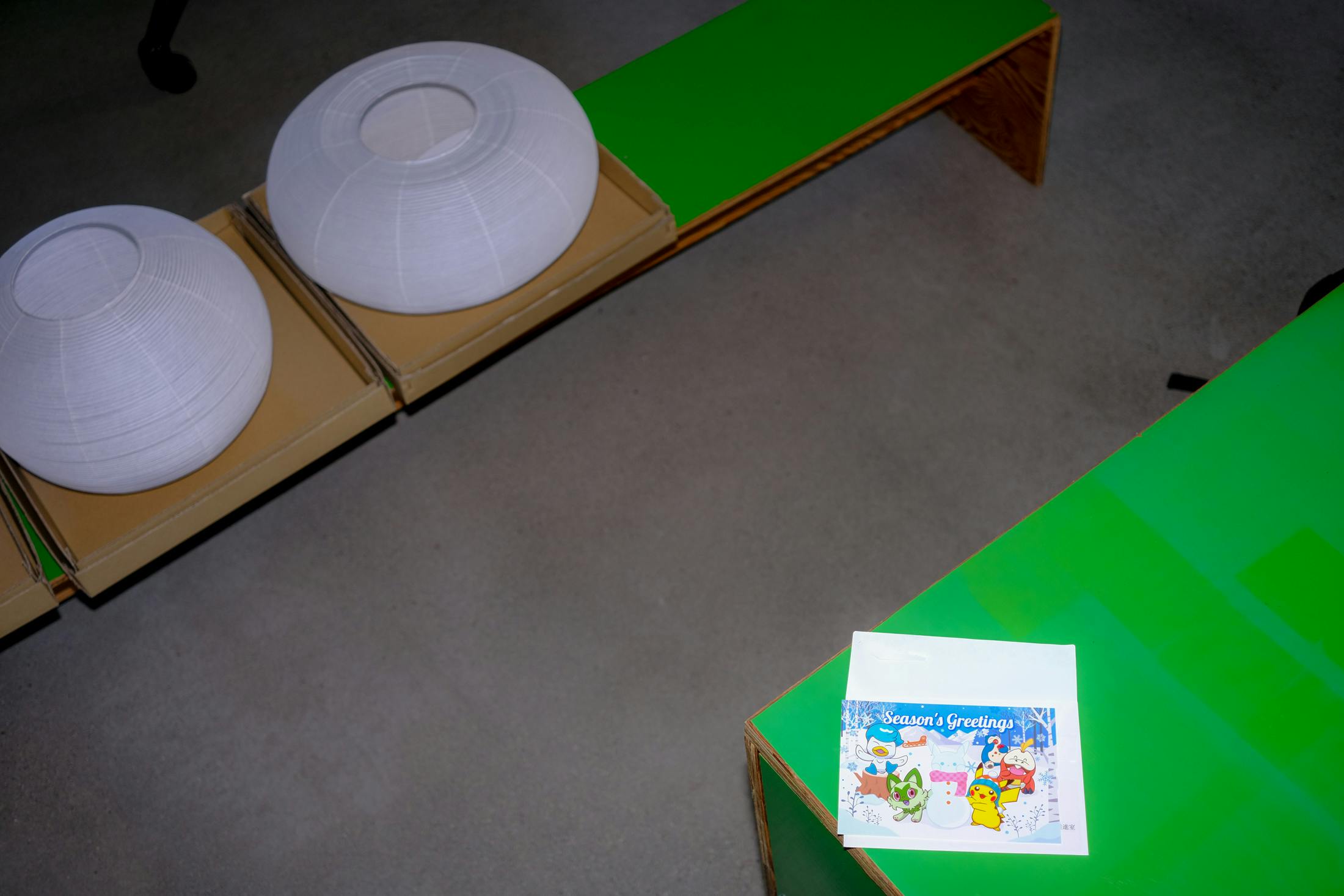
Did you have any difficulties in establishing your own style? Also, what was the moment when you arrived at something that you didn’t want to compromise on?
ご自身のスタイルを確立するっていうところまでに苦労はありましたか?また、ここだけは自分の譲れないもの(レッドスレッツ)にたどり着いた時はどんな時でしたか?
I can feel confused at times, but I still think I like what I'm doing. Then, when someone who comes with fresh eyes sees my work and praises it, it becomes clear to me what my core beliefs are. But the things I like haven't changed much. I've always known what I react to, but I feel like I've refined my work more and more through meeting and talking with different people.
I also think it's interesting to see what elements people react to in my work. I also like to see how people who like my work dress, and what fashion they’re into. Of course, it's also very motivating when a ceramics academic sees my work and tells me to “just go with it”. Seeing how people react to what I have created becomes an opportunity for me to reconsider my work.
モンモンとしながら、でも、「自分はやっぱりこれが好きなんだな」と思える時ってあると思うんですよ。それを全然知らない人が見て褒めてくれた時に、自分のぶれないものが何かがクリアになったりする。でもそもそも、自分自身の好きなものはずっとあまり変わってないですよね。自分が何に反応するかっていう、それはもうずっとブレてないけど、いろんな人と会って会話していくことで少しずつ精度が上がってきた感じがします。
あとは、どんなスタイルの人が僕自身の作品に反応してくれてるのかを見ることも面白いと思っています。反応してくれる人の服装を見て、こういう方が僕の作品を見て反応してくれるんだという気づきも面白い。もちろん、アカデミックに陶芸を知っている人に評価されて、「そのままで行け」って言われたら、それもすごく刺激になります。自分を通してできたものに対して誰がどんな反応をしてくれるかっていうことは、自分の作品を捉え直すきっかけになりますね。
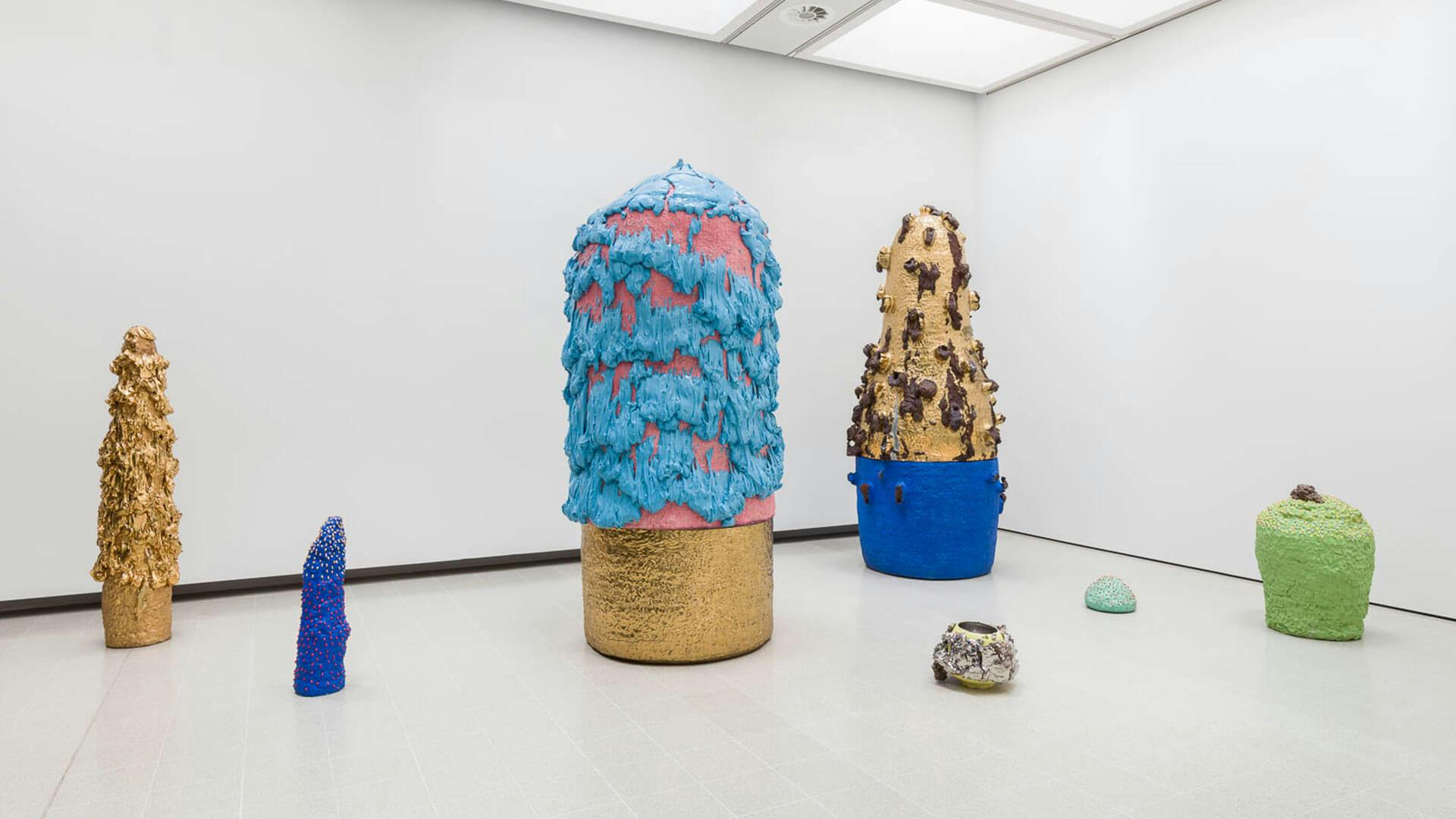
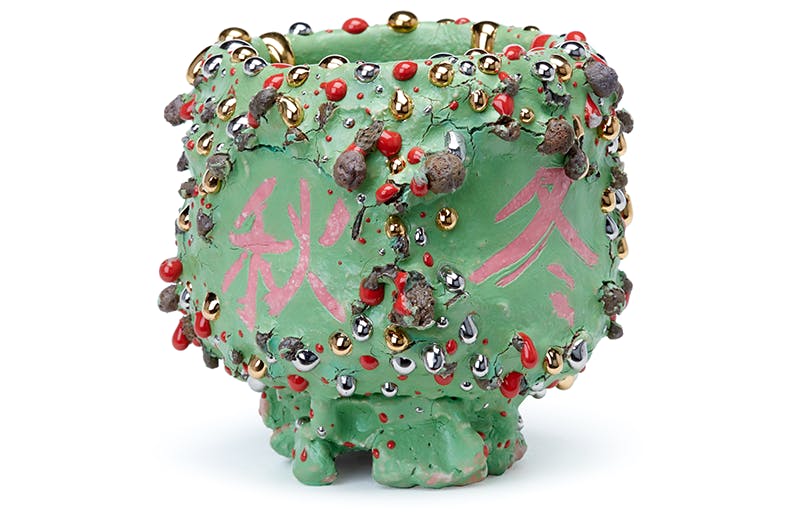
I saw earlier that you are currently experimenting with other materials such as copper and metal. What other materials would you like to use in your creations?
銅やメタルなど他のマテリアルも試されているようですが、 他にはどんなマテリアルを使って制作したいですか?
It depends on the encounter. Even if I use other materials, I'm the kind of person who can't immediately make something better unless I take my time to work on it. So, for example, even with paper, the inspiration will come over time, if you keep it in your mind. When it comes to client work, time is limited, so I have to be more strict about deadlines.
However, I'm interested in creating something that goes beyond my previous experiences. Up until now, I've been making things by myself, but I'm really interested in collaborating to create something bigger, something, beyond the scope of what you can do on your own. I'm interested in something on such a large scale, such as architecture projects.
I'm also interested in creating a community with one set of values. Even if it's not tangible, it's good to have a place to share sensibilities under a brand umbrella. If we can share one set of values, these will remain even after I die.
それは出会い次第ですね。どんな素材でも、僕はじっくり時間をかけたい。すぐに何かいいものには変えれないような人だと思うんです。だから、例えば素材が紙だったとしても、マテリアルを自分の近くに置いておききながらコミュニケーションを取って、それが煮詰まった時に何かが起こる。クライアントワークになると時間も限られているので、もっと意図的に時間を詰めていかなければならないんですけどね。
ただ、自分のこれまで経験してきた範囲だけじゃないものを作るのは興味がある。これまで1人で作ってきたけど、誰かとコラボレーションしてもっと大きなものをつくるとか、そういうものにはすごく興味があったりはしますね。自分でできるものの範囲を超えているもの。例えば、建築とか。ああいう大きいスケールのものっていうのは興味があったりします。
あと実は、1つの価値観を軸にコミュニティを作ることにも興味があって。形になるものじゃなくても、感覚的を共有する場とか、ブランドもいいですね。価値観を共有できれば、僕が死んでも残っていく。
I want to create an opportunity! I'm very interested in what kind of activities you will go into from now on, and what kind of creations you will be doing outside of pottery.
わたしも桑田さんと一緒にそんな機会を作りたいです!ご自身がこれからどんな活動を広げていくか、陶芸以外にもどんなクリエイションをしていくのがとても興味があります。
I think the time will come. I don't know if it will be next year or ten years from now, but I'm sure it will be great. I want to do my best with what's in front of me and go from strength to strength to take on new challenges in a better position.
それが来年なのか、10年後かもわからないけど、きっとすごくいい仕事になると思いますね。できる時は来ると思います。僕は今目の前にあることを頑張ってしっかり力をつけて、より良い体勢で新しいことにチャレンジできるように力を蓄えたいです。

